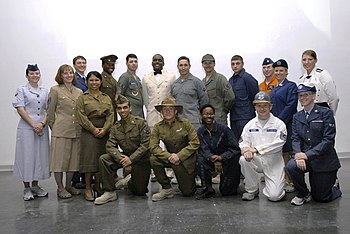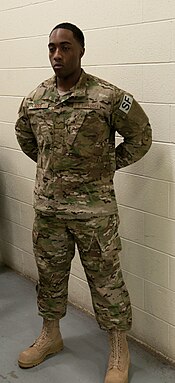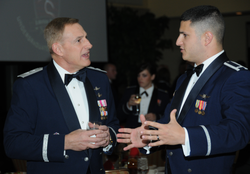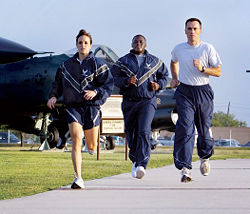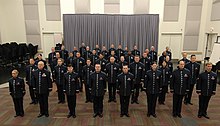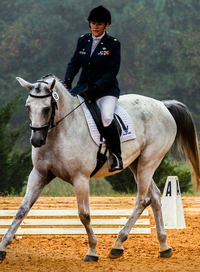Uniforms of the United States Air Force
When the U.S. Air Force first became an independent service in 1947, its members initially continued to wear green U.S. Army uniforms with distinct badges and insignia.
These continued to be issued until the extensive stocks were either transferred to the Army or depleted, leading to the green uniforms being seen into the early 1950s.
Replacement of polished brass devices with oxidized silver ones and lack of sewn unit insignia on the dress uniform were designed to reduce needless tasks and present a sleeker appearance.
An Eisenhower jacket, also inherited from the Army Air Forces but in Shade 1683, was an optional uniform item; it was phased out by 1965.
Tan summer service dress uniforms for officers, nicknamed "silver-tans" for the sheen of their Shade 193 color, saw use into the mid-1960s, while a brief-lived enlisted version which included a cotton bush jacket was introduced in 1956 and discontinued in 1965.
Tan short-sleeve cotton shirts and trousers for males, known as 1505s after their shade, continued in use until the early 1970s, while females wore light-blue combinations.
The white uniform was identical in cut and style to the blue version and also incorporated the metallic sleeve braid and shoulder board rank insignia.
In 1993, then Air Force Chief of Staff, Merrill McPeak introduced a new three-button service coat which featured no epaulets and silver sleeve braid loops on the lower sleeves denoting officer rank (see also: United States Air Force officer rank insignia).
[5][6] In 2007, Air Force officials announced they had settled on the "Hap Arnold" look, with a belted suit coat.
[7] However, in 2009, General Norton Schwartz, the new Chief of Staff of the Air Force, directed that "no further effort be made on the [Hap Arnold] Heritage Coat" so that the focus would remain on near-term uniform needs.
[14] The current U.S. Air Force Service Dress Uniform, which was initially adopted in 1994 and made mandatory on 1 October 1999, consists of a three-button coat with silver-colored buttons featuring a design known as "Hap Arnold wings", matching trousers (women may choose to wear a matching skirt), and either a peaked service cap or flight cap, all in Shade 1620, also known as "Air Force Blue".
While the full "Class A" configuration of the service dress uniform includes the coat, for daily duty, particularly in warm weather climates, USAF personnel will typically wear the light blue shirt or blouse as an outer garment, with or without a tie or neck tab, with applicable rank insignia, speciality badges and a blue plastic name tag (ribbons are optional).
[15] The jacket features ornate silver buttons, and is worn with the service member's awarded medals in miniature size, wings in miniature size, or other specialty insignia over the left breast, command insignia over the right breast for colonels and below (if applicable), satin air force blue bow-tie for males or tab for females, and a satin air force blue cummerbund.
The Air Force Physical Training Uniform (AFPTU), first released on 1 October 2006, consists of shorts, short-sleeve and long-sleeve T-shirts, jackets, and pants.
The T-shirts are light grey with moisture-wicking fabric with reflective Air Force logos on the upper left portion of the chest and across the back.
As with other United States military bands, drum-majors may replace the blue peaked hat with a bearskin helmet, and add a baldric with campaign ribbons.
The Air Force Chief of Staff and the Chief Master Sergeant of the Air Force are authorized to wear a special ceremonial uniform consisting of a stand-collar coat and braided trousers similar to the ceremonial band uniform, with the addition of a silver braid trimmed belt.
The equestrian uniform is similar to service dress, but features white riding breeches in lieu of blue trousers.
Bandsmen, recruiters, chaplains, and fitness center staff are permitted to wear the Air Force "informal uniform" while on duty.
This civilian business casual–style dress consists of an Air Force blue polo shirt with embroidered emblem, khaki trousers, and solid black low quarter or athletic shoes.
[23] As with the U.S. Army and U.S. Marine Corps, drill instructors in the U.S. Air Force—known as Military Training Instructors—are authorized to wear a campaign hat.
The Air Force campaign hat is navy blue and features the Great Seal of the United States within a silver ring.
It was disbanded in 1893 following the annexation of Hawaii by the United States, overthowing Queen Lili'uokalani and installing Sanford Dole as governor of the new territory.
[32] The uniform of the Royal Guard is based on the 1885 dark blue service dress tunic and a white spiked cork pith helmet introduced for the funeral procession for Queen Emma.
